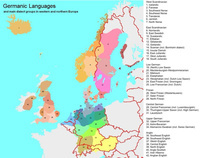Enjoy being online again!
Welcome to the community of good people who base their values on evidence and appreciate civil discourse - the social network you will enjoy.Create your free account
7 comments
Feel free to reply to any comment by clicking the "Reply" button.It looks like this map is mostly about dialects and not separate languages. It’s even more interesting this way because here, it’s clearly seen that borders don’t determine the area where a dialect or a language is spoken. And the shift between different languages is much smoother than you might think. It’s especially well seen in Western Europe, where the Germanic peoples lived for a long time and were not subjected to any external invasions that much, so they kept living in the same places for centuries.
It is how language education should look in schools because we need kids to know there are plenty of languages in this world, and they all are important, and they all deserve to be celebrated and studied
I live in Eastern Europe, but somehow a part of my ancestors come from Scandinavian countries
It'd be very interesting to see that map with Yiddish (which, for those who are unfamiliar with it, is a Germanic language, being primarily hochdeutsche with bits and pieces of Hebrew, Aramaic and various Slavic and Romance languages mixed in for good measure - as my grandmother always said, "Yiddish is high German with the best swearwords from all the other countries Jewish people live in" ) also included - Germanic languages would then be spoken in almost all the countries of Europe, as well as several in Asia, Africa and the Americas.
According to 23andMe, the vast majority of my DNA came from those countries.
Very interesting. I didn’t know there were so many variations.
In addition, world-wide there’s English spoken around the world of course. Those Germanic tribes made their mark on the world.
Enjoy being online again!
Welcome to the community of good people who base their values on evidence and appreciate civil discourse - the social network you will enjoy.Create your free account
Share this post
Categories
Agnostic does not evaluate or guarantee the accuracy of any content. Read full disclaimer.









